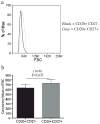Naïve and memory B cells in the rhesus macaque can be differentiated by surface expression of CD27 and have differential responses to CD40 ligation
- PMID: 20875419
- PMCID: PMC3357916
- DOI: 10.1016/j.jim.2010.09.017
Naïve and memory B cells in the rhesus macaque can be differentiated by surface expression of CD27 and have differential responses to CD40 ligation
Abstract
The rhesus macaque (RM) model has the potential to be an invaluable tool for studying B cell populations during pathogenic infections, however, to date, there has been no definitive delineation of naïve and memory B cell populations in the RM. This has precluded a rigorous analysis of the generation, persistence and resolution of a pathogen-specific memory B cell response. The present study utilized multiple analyses to demonstrate that CD27 expression on B cells is consistent with a memory phenotype. Compared to CD20+CD27- B cells, CD20+CD27+ B cells were larger in size, and preferentially accumulated at effector sites. Direct sequence analysis revealed that CD20+CD27+ B cells had an increased frequency of point mutations that were consistent with somatic hypermutation and at a functional level, CD40 ligation improved CD20+CD27- but not CD20+CD27+ B cell survival in vitro. These data provide definitive evidence that the naïve and memory B cell populations of the RM can be differentiated using surface expression of CD27.
Copyright © 2010. Published by Elsevier B.V.
Figures







Similar articles
-
The different process of class switching and somatic hypermutation; a novel analysis by CD27(-) naive B cells.Blood. 2002 Jan 15;99(2):567-75. doi: 10.1182/blood.v99.2.567. Blood. 2002. PMID: 11781240
-
Memory B cells and CD27.Histol Histopathol. 2000 Apr;15(2):573-6. doi: 10.14670/HH-15.573. Histol Histopathol. 2000. PMID: 10809378 Review.
-
Humans with chronic granulomatous disease maintain humoral immunologic memory despite low frequencies of circulating memory B cells.Blood. 2012 Dec 6;120(24):4850-8. doi: 10.1182/blood-2012-05-430959. Epub 2012 Oct 16. Blood. 2012. PMID: 23074274 Free PMC article.
-
Reduced expression of CD27 by collagenase treatment: implications for interpreting b cell data in tissues.PLoS One. 2015 Mar 10;10(3):e0116667. doi: 10.1371/journal.pone.0116667. eCollection 2015. PLoS One. 2015. PMID: 25756877 Free PMC article.
-
Plasma cell generation from B-lymphocytes via CD27/CD70 interaction.Leuk Lymphoma. 1999 Oct;35(3-4):219-25. doi: 10.3109/10428199909145724. Leuk Lymphoma. 1999. PMID: 10706444 Review.
Cited by
-
Alterations in peripheral blood B-cell populations in SHIV89.6P-infected macaques (Macacca fascicularis).Comp Med. 2011 Jun;61(3):269-77. Comp Med. 2011. PMID: 21819698 Free PMC article.
-
Zika viral dynamics and shedding in rhesus and cynomolgus macaques.Nat Med. 2016 Dec;22(12):1448-1455. doi: 10.1038/nm.4206. Epub 2016 Oct 3. Nat Med. 2016. PMID: 27694931 Free PMC article.
-
Primate B-1 cells generate antigen-specific B cell responses to T cell-independent type 2 antigens.J Immunol. 2013 Apr 1;190(7):3100-8. doi: 10.4049/jimmunol.1203058. Epub 2013 Mar 1. J Immunol. 2013. PMID: 23455507 Free PMC article.
-
TFH Cells Induced by Vaccination and Following SIV Challenge Support Env-Specific Humoral Immunity in the Rectal-Genital Tract and Circulation of Female Rhesus Macaques.Front Immunol. 2021 Jan 28;11:608003. doi: 10.3389/fimmu.2020.608003. eCollection 2020. Front Immunol. 2021. PMID: 33584682 Free PMC article.
-
Long-Term Recovery of the Adaptive Immune System in Rhesus Macaques After Total Body Irradiation.Adv Radiat Oncol. 2021 Apr 19;6(5):100677. doi: 10.1016/j.adro.2021.100677. eCollection 2021 Sep-Oct. Adv Radiat Oncol. 2021. PMID: 34646962 Free PMC article.
References
-
- Agematsu K, Kobata T, Yang FC, Nakazawa T, Fukushima K, Kitahara M, Mori T, Sugita K, Morimoto C, Komiyama A. CD27/CD70 interaction directly drives B cell IgG and IgM synthesis. Eur J Immunol. 1995;25:2825. - PubMed
-
- Agematsu K, Nagumo H, Yang FC, Nakazawa T, Fukushima K, Ito S, Sugita K, Mori T, Kobata T, Morimoto C, Komiyama A. B cell subpopulations separated by CD27 and crucial collaboration of CD27+ B cells and helper T cells in immunoglobulin production. Eur J Immunol. 1997;27:2073. - PubMed
-
- Agematsu K, Hokibara S, Nagumo H, Komiyama A. CD27: a memory B-cell marker. Immunol Today. 2000;21:204. - PubMed
-
- Arpin C, Dechanet J, Van Kooten C, Merville P, Grouard G, Briere F, Banchereau J, Liu YJ. Generation of memory B cells and plasma cells in vitro. Science. 1995;268:720. - PubMed
-
- Avery DT, Ellyard JI, Mackay F, Corcoran LM, Hodgkin PD, Tangye SG. Increased expression of CD27 on activated human memory B cells correlates with their commitment to the plasma cell lineage. J Immunol. 2005;174:4034. - PubMed
Publication types
MeSH terms
Substances
Grants and funding
LinkOut - more resources
Full Text Sources
Research Materials

